A Holistic Approach for Addressing the Issue of Effective Technology Transfer in the Frame of Climate Change
Abstract
:1. Introduction
2. The Philosophy
2.1. 1st Component—Assess
2.2. 2nd Component—Identify
2.3. 3rd Component—Define
3. The Methodological Approach
- Initially the indicators that reflect the current state of the host country, so as to consolidate and better understand its specific characteristics are identified.
- A broad range of sub-sectors or energy services are identified for the study. The study focuses on mitigation types of action only.
- Selection of technologies that are rather broad by identifying from a range of literature sources, clean, sustainable energy technologies that might be applicable for the host country.
- The factors that affect and contribute to the technology transfer are identified.
- Identification of supporting actions for technology transfer for each country context and implemented as an integral part of the transfer process.
3.1. Participatory Approach
3.2. Energy Services
3.3. Modified Fuzzy Technique for Order Preference by Similarity to Ideal Solution
3.4. 1st Screening: Linguistic Ordered Weighted Averaging
3.5. Energy Service Needs and Priorities List
3.6. Sustainable Energy Technologies
3.7. ELECTRE TRI
3.8. Priority Sustainable Energy Technologies List
3.9. Market Mapping
3.10. Sustainable Development Benefits Assessment
3.11. Time Series Analysis
3.12. Technology Transfer Variables
3.13. Strategic Action Plans
3.14. Econometric Model
3.15. Priority Strategic Actions List
4. Key Features of the Approach
4.1. 1st Component—Assess: Assessment of the Host Country Needs and Priorities
- N1: Electricity for industry
- N2: Electricity for agriculture
- N3: Electricity for households: rural communities
- N4: Electricity for households: urban communities
- N5: Electricity for service sectors
- N6: Heat for industry
- N7: Heat for households
- N8: Heat for service sectors
4.2. 2nd Component–Identify: Identification of the most Appropriate Sustainable Energy Technologies
- K1—Accordance with strategic/developmental planning: Reflects the accordance of particular technologies with the strategic and developmental planning of each country. The higher the accordance with strategic planning in a specific country the higher the performance of a specific technology in this criterion;
- K2—Local and regional economic development: Represents the repercussion of a particular technology in the local and regional development. It does not include the impact on the employment, while it incorporates the extent to which the local enterprises bloom due to the investments in the region. The higher the growth achieved the higher the performance;
- K3—CO2 emissions reduction: Represents the estimated reduction of CO2 emissions that will be achieved via the implementation of each alternative. The choices with the higher possible reduction are evaluated higher than the options with lower CO2 reduction potential;
- K4—Minimization of the negative effects on the Natural environment at national—regional level: Reflects the level of repercussion of the alternative in the natural environment, incorporating the noise levels, aesthetic interruptions, pressure on land resources and excessive land use. Options with the least possible impact are ranked higher;
- K5—Contribution to the employment: The criterion is about the social impact that the alternative has, as far as the employment rates are concerned. The higher the contribution to net employment generation, the higher the performance in this criterion;
- K6—Contribution to the energy sufficiency (independence): This criterion depicts the extent to which each examined option contributes to the country’s energy independence, by substituting certain amounts of the consumed primary energy.
4.3. 3rd Component—Define: Definition of Strategic Actions for the Promotion of Technology Transfer
- Sa: Technology information
- Sa1: Implementation of training programmes and workshops for building capacity in technology information
- Sa2: Elaboration of national communications with information on technology transfer activities
- Sa3: Elaboration of technical studies that explore barriers, good practices and recommendations
- Sa4: Elaboration of reports on the Research and Development (R&D) needs
- Sa5: Establishment of technology information centres and networks
- Sb: Enabling environment
- Sb1: Creation of an environment conducive to investment
- Sb2: Strengthening the regulatory frameworks/enhancement of legal systems
- Sb3: Integration of technology transfer into national policies
- Sb4: Bilateral and multilateral cooperation programmes for the promotion of technology transfer
- Sb5: Policy arrangements for the promotion of international scientific and technological cooperation
- Sc: Capacity building
- Sc1: R&D funding programs
- Sc2: Elaboration of reports on capacity-building needs and experiences of the host country relating to the development, deployment, diffusion and transfer of technologies
- Sc3: Activities to increase, enhance or improve awareness and knowledge of sustainable energy technologies and their transfer in a host country
- Sc4: Establishment of national or regional R&D centers
- Sc5: Provision or support training activities for the development and transfer of technologies in a host country
5. Pilot Appraisal
- Fuzzy TOPSIS group decision support system (FT-GDSS), which integrates customised properly the multicriteria method fuzzy TOPSIS for group decision making, an extension of the TOPSIS method to the fuzzy environment, for the assessment of the developing country’s energy needs and priorities.
- ELECTRE TRI decision support system (ET-DSS), which incorporates the multicriteria method ELECTRE TRI customised methodologically for the assessment of the most suitable sustainable energy technologies to meet a developing country’s energy needs and priorities.
- Technology transfer decision support system (TT-DSS), which integrates appropriately formulated econometric model combined with a rule based system for diagnosing the current situation and the level of infrastructure of the host country, as well as the indication of specific strategies so as to achieve “real” technology transfer.
5.1. Energy Services Priorities
- Chile: Stakeholders underscored that increased access and reliable electricity for households and industry are essential. Stakeholders through the approach highlighted that increased access and reliable electricity for households and the industrial sector are essential. This is in line with the country’s main considerations for energy delivery through imports and security of electricity supply for households and industry, due to energy supply instabilities the country faced in the past.
- China: Stakeholders pointed out as a high priority for China the efficient, reliable and affordable supply of electricity and heat in industry. These needs and priorities are essential also according to national policy for the country to achieve its energy and environmental goals and ensure sustainable development.
- Israel: Israel has rapidly growing energy needs that are mainly related to electricity supply for the residential sector and the industry. The approach followed emphasized the need for increased access to reliable and affordable electricity for the residential sector, which is realistic, as this sector is responsible for the country’s increasing energy consumption. Moreover, issues relating to energy security arose by local stakeholders.
- Kenya: There was a common understanding among the stakeholders that access to reliable and affordable modern energy supplies is one of the key requirements for Kenya’s sustainable development. Based on the above, stakeholders’ preferences led to a wide range of energy service needs and priorities and perhaps this reflects the necessity of transferring sustainable energy technologies to the country.
- Thailand: In Thailand stakeholders focused mainly on the industrial sector rather than on household sectors when assessing needs and priorities. This was explained by experts, among others from the fact that the Thai industry is characterized by increased efforts to improve energy efficiency, considering the circumstances, such as the rising energy prices and the tougher competition.
5.2. Sustainable Energy Technologies Priorities
- Biomass is a high priority for all the countries except China, due to its sustainable characteristics and related potential to be applied. This technology seems could contribute to the sustainable development goal and there is untapped potential for implementation in all countries examined.
- Wind energy is a high priority to all countries, especially for isolated regions, since wind technology can be considered as fully commercialized and mature.
- For all case study countries oil is not considered as a high priority alternative for electricity generation. Countries tend to become independent from oil, as far as electricity generation is concerned, due to the high costs and uncertainties related with oil supply.
- Coal-to-gas is a high priority only for the case of Israel, which has great offshore natural gas reserves, has established a strategic communication to allow the import of Egyptian natural gas and tends to rely more on intern sources. On the contrary, this technology does not seem appealing for the rest of the countries due to the high import costs of natural gas.
- Electricity production of methane from coal mining is an alternative technology with great economic, environmental and social benefits, but can only be applied in countries with significant coal reserves. Therefore, only in China and Israel is this technology applicable. For the other countries examined this technology is not recommended.
5.3. Technology Transfer Strategic Actions
6. Conclusions
- Energy Needs and Priorities: The high priority energy need that emerged for all the five host countries examined through the pilot application of the proposed methodology, taking into account the overall medium to long-term energy and environmental strategy of each developing country is electricity production.
- High Priority Sustainable Energy Technologies: Climate change may change the host country’s energy needs over time and this, as expected, affects the technological needs of the country. The results led to technologies related to the domestic energy potential of these countries. The priority sustainable energy technologies are fully commercialized and matured enough, with significant sustainability benefits, economic, environmental and social, for the host countries.
- Strategic Technology Transfer Actions: The transfer of sustainable energy technologies should be linked to the country’s national strategies, while strengthening the local economic activity, capacity and infrastructure. By identifying the factors influencing technology transfer in the five host countries, the application proposed concrete strategic actions promoting the effective technology transfer, directly linked to the resulting as priority sustainable energy technologies in each host country under examination.
Acknowledgments
Conflicts of Interest
References
- Hoekman, B.M.; Maskus, K.E.; Saggi, K. Transfer of technology to developing countries: unilateral and multilateral policy options. World Dev. 2005, 33, 1587–1602. [Google Scholar] [CrossRef]
- Ojoo-Massawa, E. Sustainable Development Benefits Delivered by the Clean Development Mechanism; National Environment Management Authority (NEMA): Nairobi, Kenya, 2007. [Google Scholar]
- Popp, D. International Technology Transfer for Climate Policy, Policy Brief; Syracuse University, Center for Policy Research, Maxwell School of Citizenship and Public Affairs: Syracuse, NY, USA, 2008. [Google Scholar]
- Doukas, H.; Patlitzianas, D.K.; Papadopoulou, A.; Psarras, J. Foresight of innovative energy technologies through a multi criteria approach. Int. J. Energy Technol. Policy 2008, 6, 381–394. [Google Scholar] [CrossRef]
- Ockwell, G.D.; Watson, J.; MacKerron, G.; Pal, P.; Yamin, F. Key policy considerations for facilitating low carbon technology transfer to developing countries. Energy Policy 2008, 36, 4104–4115. [Google Scholar] [CrossRef]
- Leal-Arcas, R.; Carafa, L. Road to Paris COP21: Towards soft global governance for climate change. Renew. Energy Law Policy Rev. 2014, 2, 130–135. [Google Scholar]
- Karakosta, C.; Doukas, H.; Psarras, J. A decision support approach for the sustainable transfer of energy technologies under the Kyoto protocol. Am. J. App. Sci. 2008, 5, 1720–1729. [Google Scholar] [CrossRef]
- Wilkins, G. Technology Transfer for Renewable Energy: Overcoming Barriers in Developing Countries; Royal Institute of International Affairs/Chatham House: London, UK, 2002. [Google Scholar]
- Ramanathan, R. Successful transfer of environmentally sound technologies for greenhouse gas mitigation: A framework for matching the needs of developing countries. Ecol. Econ. 2002, 42, 117–129. [Google Scholar] [CrossRef]
- Karakosta, C.; Doukas, H.; Psarras, J. Technology transfer through climate change: Setting a sustainable energy pattern. Renew. Sustain. Energy Rev. 2010, 14, 1546–1557. [Google Scholar] [CrossRef]
- Karakosta, C.; Askounis, D. Developing countries’ energy needs and priorities under a sustainable development perspective: A linguistic decision support approach. Energy Sustain. Dev. 2010, 14, 330–338. [Google Scholar] [CrossRef]
- Karakosta, C.; Doukas, H.; Psarras, J. Directing clean development mechanism towards developing countries’ sustainable development priorities. Energy Sustain. Dev. 2009, 13, 77–84. [Google Scholar] [CrossRef]
- Implementation of the Poznan Strategic Program on Technology Transfer: A Progress Report of the GEF to the Subsidiary Body for Implementation at its Thirty-Second Session; Global Environment Facility (GEF): Washington, DC, USA, 2010.
- Burns, A.; Timmer, H.; Riordan, E.M.; Shaw, W.; David, A.; Decreux, Y.; Sulla, O. Global Economic Prospects: Technology Diffusion in the Developing World; The World Bank: Washington, DC, USA, 2008. [Google Scholar]
- Report of the Conference of the Parties on its Fourteenth Session, held in Poznan from 1 to 12 December 2008; Part One; United Nations Framework Convention on Climate Change (UNFCCC): Geneva, Switzerland, 2009.
- Kowalski, K.; Stagl, S.; Madlener, R.; Omann, I. Sustainable energy futures: methodological challenges in combining scenarios and participatory multi-criteria analysis. Eur. J. Oper. Res. 2009, 197, 1063–1074. [Google Scholar] [CrossRef]
- Karakosta, C.; Flamos, A.; Doukas, H.; Vaturi, A. Sustainable energy technology transfers through the CDM? Application of participatory approaches for decision making facilitation. Int. J. Environ. Policy Decis. Mak. 2010, 1, 1–16. [Google Scholar] [CrossRef]
- Karakosta, C.; Doukas, H.; Psarras, J. CDM Sustainable Technology Transfer Grounded in Participatory In-Country Processes in Israel. Int. J. Sustain. Soc. 2011, 3, 225–242. [Google Scholar] [CrossRef]
- Chen, T.C. Extensions of the TOPSIS for group decision making under fuzzy environment. Fuzzy Sets Syst. 2000, 114, 1–9. [Google Scholar] [CrossRef]
- Karakosta, C.; Psarras, J. Fuzzy TOPSIS approach for understanding a country’s development priorities within the scope of climate technology transfer. Adv. Energy Res. 2012, 9, 123–149. [Google Scholar]
- Herrera, F.; Herrera-Viedma, E. Linguistic decision analysis: steps for solving decision problems under linguistic information. Fuzzy Sets Syst. 2000, 115, 67–82. [Google Scholar] [CrossRef]
- Mousseau, V.; Slowinski, R. Inferring an ELECTRE TRI model from assignment examples. J. Glob. Optim. 1998, 12, 157–174. [Google Scholar] [CrossRef]
- Mousseau, V.; Slowinski, R.; Zielniewicz, P. ELECTRE TRI 2.0 a Methodological Guide and User’s Manual. Doc. LAMSADE 1999, 111, 263–275. [Google Scholar]
- Albu, M.; Griffith, A. Mapping the Market: A Framework for Rural Enterprise Development Policy and Practice; Practical Action Publishing: Warwickshire, UK, 2005. [Google Scholar]
- Subbarao, S.; Lloyd, B. Can the clean development mechanism (CDM) deliver? Energy Policy 2011, 39, 1600–1611. [Google Scholar] [CrossRef]
- Bazeley, P.; Richards, L. The NVivo Qualitative Project Book; Sage Publications Inc.: London, UK, 2000. [Google Scholar]
- NVivo Qualitative Data Analysis Software; Version 7; QSR International Pty Ltd.: Doncaster, Australia, 2006.
- Goldman, L.I. Crystal Ball Professional Introductory Tutorial. In Proceedings of the Simulation Conference of the Winter, San Diego, CA, USA, 8–11 December 2002; Volume 2, pp. 1539–1545.
- Doukas, H.; Botsikas, A.; Psarras, J. Multi-criteria decision aid for the formulation of sustainable technological energy priorities using linguistic variables. Eur. J. Oper. Res. 2007, 182, 844–855. [Google Scholar] [CrossRef]
- Doukas, H.; Karakosta, C.; Psarras, J. Computing with words to assess the sustainability of renewable energy options. Expert Syst. Appl. 2010, 37, 5491–5497. [Google Scholar] [CrossRef]
- Doukas, H. Modelling of linguistic variables in multicriteria energy policy support. Eur. J. Oper. Res. 2013, 227, 227–238. [Google Scholar] [CrossRef]
- Doukas, H.; Tsiousi, A.; Marinakis, V.; Psarras, J. Linguistic multi-criteria decision making for energy and environmental corporate policy. Inf. Sci. 2014, 258, 328–338. [Google Scholar] [CrossRef]
- ENTTRANS Report Summary: The Potential of Transferring and Implementing Sustainable Energy Technologies through the Clean Development Mechanism of the Kyoto Protocol; The European Commission: Groningen, The Netherlands, 2008.
- Karakosta, C.; Marinakis, V.; Letsou, P.; Psarras, J. Does the CDM Offer Sustainable Development Benefits or not? Int. J. Sustain. Dev. World Ecol. 2013, 20, 1–8. [Google Scholar] [CrossRef]
- Karakosta, C.; Doukas, H.; Psarras, J. Sustainable energy technologies in Israel under the CDM: Needs and prospects. Renew. Energy 2009, 34, 1399–1406. [Google Scholar] [CrossRef]
- Brito, A.J.; De Almeida, A.T.; Mota, C.M. A multicriteria model for risk sorting of natural gas pipelines based on ELECTRE TRI integrating utility theory. Eur. J. Oper. Res. 2010, 200, 812–821. [Google Scholar] [CrossRef]
- Wang, J.J.; Jing, Y.Y.; Zhao, J.H. Multi Criteria Evaluation Model of Renewable Energy Power Plants Based on ELECTRE Method. In Proceedings of the ASME 2009 3rd International Conference on Energy Sustainability, San Francisco, CA, USA, 19–23 July 2009; pp. 467–473.
- Yu, W. ELECTRE TRI: Aspects Méthodologiques et Manuel d’Utilisation; Document-Université de Paris-Dauphine, LAMSADE: Dauphine, Paris, 1992. (In French) [Google Scholar]
- Doukas, H.; Karakosta, C.; Psarras, J. RES technology transfer within the new climate regime: A “Helicopter” view under the CDM. Renew. Sustain. Energy Rev. 2009, 13, 1138–1143. [Google Scholar] [CrossRef]
- Joint Implementation Quarterly. ENTTRANS: Assessment of Technology Implementation Chains in CDM Host Countries. Magazine on the Kyoto Mechanisms: Paterswolde, The Netherlands, 13 July 2007; 6–7. [Google Scholar]
- Matysek, A.; Ford, M.; Jakeman, G.; Gurney, A.; Fisher, S.B. Technology: Its Role in Economic Development and Climate Change; Canberra, Australian Bureau of Agricultural and Research Economics (ABARE): Canberra, Australia, 2006. [Google Scholar]
- Renewables “Global Status Report”; Renewable Energy Policy Network for the 21st Century: Paris, France, 2010.
- The World Alliance for Decentralized Energy; The World Alliance for Decentralized Energy (WADE): Edinburgh, UK, 2003.
- Clean Coal—Building a Future through Technology; World Coal Institute (WCI): London, UK, 2004.
- Bazmi, A.A.; Zahedi, G. Sustainable energy systems: Role of optimization modeling techniques in power generation and supply—A review. Renew. Sustain. Energy Rev. 2011, 15, 3480–3500. [Google Scholar] [CrossRef]
- Chai, Q.; Zhang, X. Technologies and policies for the transition to a sustainable energy system in China. Energy 2010, 35, 3995–4002. [Google Scholar] [CrossRef]
- European Union (EU) Directive E.C.32/EC of the European Parliament and of the Council of 5 April 2006 on Energy End-Use Efficiency and Energy Services and Repealing Council Directive 93/76/EEC, (Text with EEA relevance). Off. J. Eur. Union 2006, 114, 64–84.
- European Union (EU) Directive 2009/28/EC of the European Parliament and of the Council of 23 April 2009 on the Promotion of the Use of Energy from Renewable Sources and Amending and Subsequently Repealing Directives 2001/77/EC and 2003/30/EC, (Text with EEA relevance). Off. J. Eur. Union 2009, 140, 16–62.
- European Union (EU) Directive 2010/31/EU of the European Parliament and of the Council of 19 May 2010 on the Energy Performance of Buildings (recast). Off. J. Eur. Union 2010, 153, 13–35.
- Jansen, L. The challenge of sustainable development. J. Clean. Prod. 2003, 11, 231–245. [Google Scholar] [CrossRef]
- Lior, N. Sustainable energy development: The present (2009) situation and possible paths to the future. Energy 2010, 35, 3976–3994. [Google Scholar] [CrossRef]
- CDM Methodology Booklet—Information including EB 56; United Nations Framework Convention on Climate Change (UNFCCC): Geneva, Switzerland, 2010; p. 212.
- Pappas, C.; Karakosta, C.; Marinakis, V.; Psarras, J. A comparison of electricity production technologies in terms of sustainable development. Energy Convers. Manag. 2012, 64, 626–632. [Google Scholar] [CrossRef]
- Karakosta, C.; Marinakis, V.; Psarras, J. Supporting decision makers in assessing environmental policy instruments. In Renewable Energy: Economics, Emerging Technologies and Global Practices; Poullikkas, A., Ed.; Nova Science Publishers Inc.: Hauppauge, NY, USA, 2013; pp. 15–24. [Google Scholar]
- Karakosta, C.; Psarras, J. Redefining the clean development mechanism to encourage the transfer of sustainable energy technologies. Int. J. Energy Environ. Econ. 2009, 17, 143–158. [Google Scholar]
- Fenhann, J. CDM Pipeline Overview. Available online: http://uneprisoe.org/ (accessed on 20 June 2013).
- Clean Development Mechanism Project Design Document Form (CDM PDD); Version 03.1; United Nations Framework Convention on Climate Change (UNFCCC): New York, NY, USA, 2006.
- Project Cycle Search; United Nations Framework Convention on Climate Change (UNFCCC): New York, NY, USA, 2011. Available online: http://cdm.unfccc.int/Projects/projsearch.html/ (accessed on 5 December 2012).
- Balachandra, P.; Nathan, H.S.K.; Reddy, B.S. Commercialization of sustainable energy technologies. Renew. Energy 2010, 35, 1842–1851. [Google Scholar] [CrossRef]
- Dechezleprêtre, A.; Glachant, M.; Ménière, Y. Technology transfer by CDM projects: A comparison of Brazil, China, India and Mexico. Energy Policy 2009, 37, 703–711. [Google Scholar] [CrossRef]
- Delina, L.L. Clean energy financing at Asian Development Bank. Energy Sustain. Dev. 2011, 15, 195–199. [Google Scholar] [CrossRef]
- Okazaki, T.; Yamaguchi, M. Accelerating the transfer and diffusion of energy saving technologies steel sector experience—Lessons learned. Energy Policy 2011, 39, 1296–1304. [Google Scholar] [CrossRef]
- Thorne, S. Towards a framework of clean energy technology receptivity. Energy Policy 2008, 36, 2831–2838. [Google Scholar] [CrossRef]
- Van der Gaast, W.; Begg, K.; Flamos, A. Promoting sustainable energy technology transfers to developing countries through the CDM. Appl. Energy 2009, 86, 230–236. [Google Scholar] [CrossRef]
- Wang, B. Can CDM bring technology transfer to China?—An empirical study of technology transfer in China’s CDM projects. Energy Policy 2010, 38, 2572–2585. [Google Scholar] [CrossRef]
- Zhao, Z.Y.; Zuo, J.; Feng, T.T.; Zillante, G. International cooperation on renewable energy development in China—A critical analysis. Renew. Energy 2011, 36, 1105–1110. [Google Scholar] [CrossRef]
- Dechezleprêtre, A.; Glachant, M.; Ménière, Y. The clean development mechanism and the international diffusion of technologies: An empirical study. Energy Policy 2008, 36, 1273–1283. [Google Scholar] [CrossRef]
- Zhang, C.; Yan, J. CDM’s influence on technology transfers: A study of the implemented clean development mechanism projects in China. Appl. Energy 2015, 158, 355–365. [Google Scholar] [CrossRef]
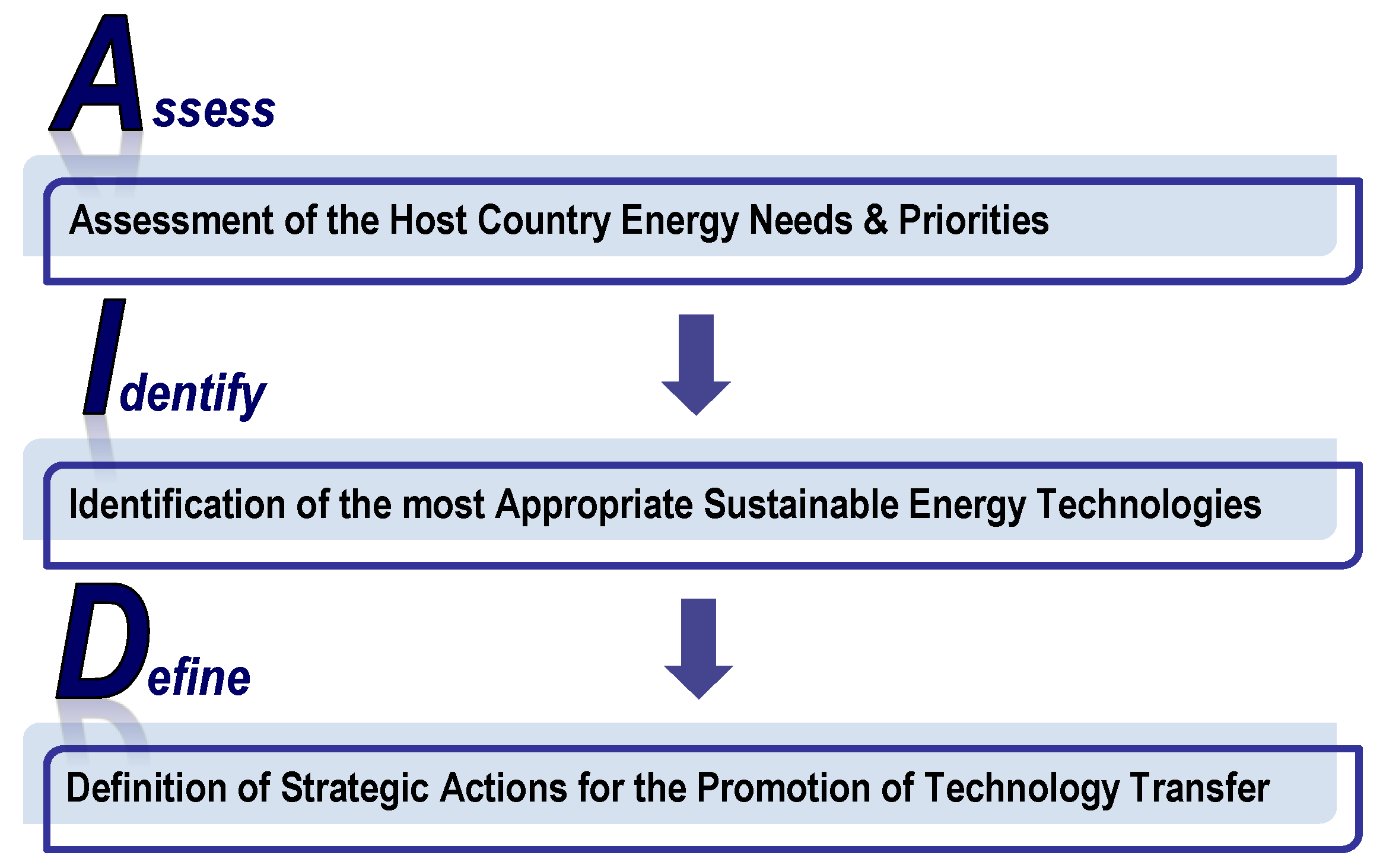

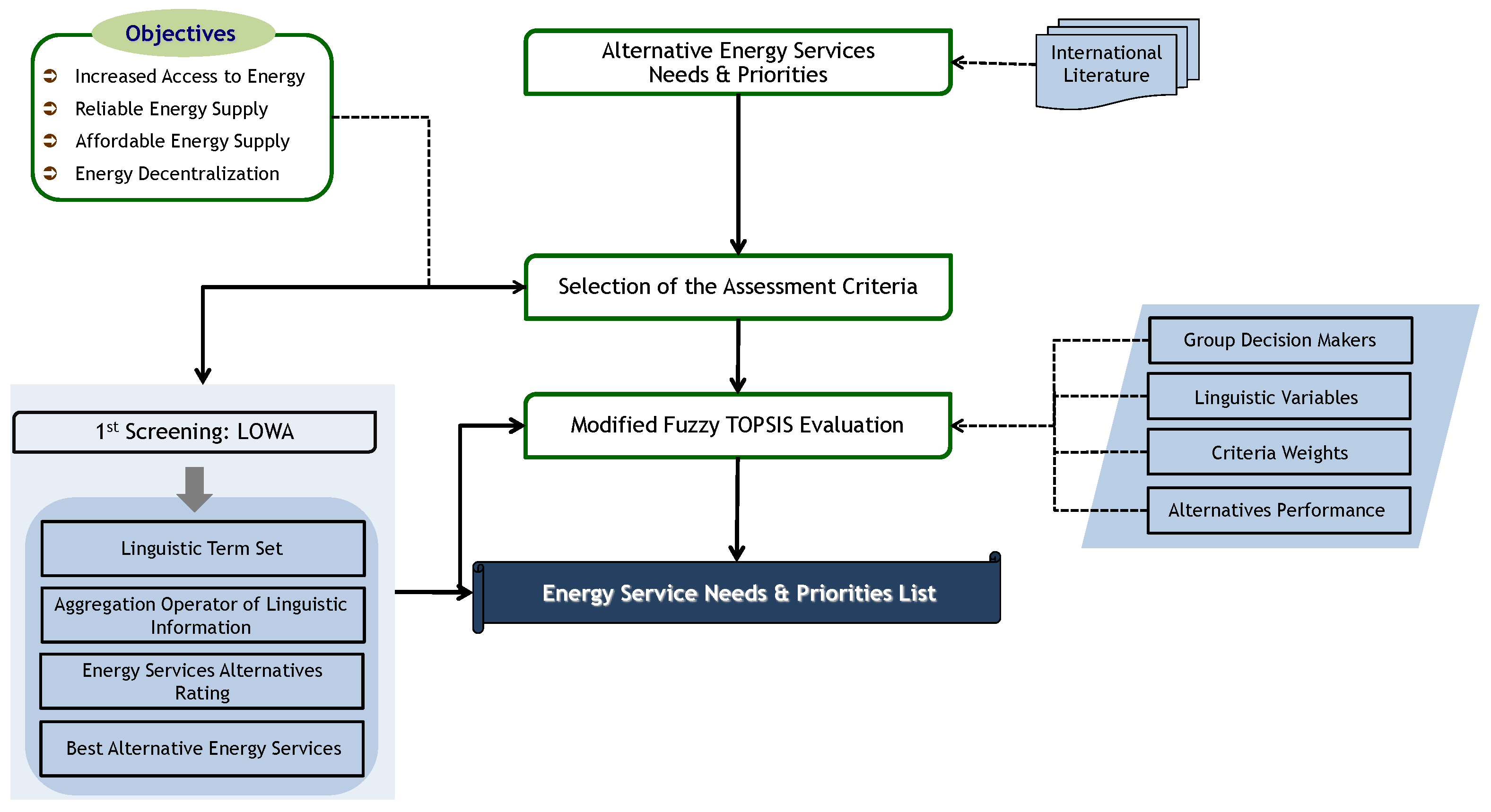
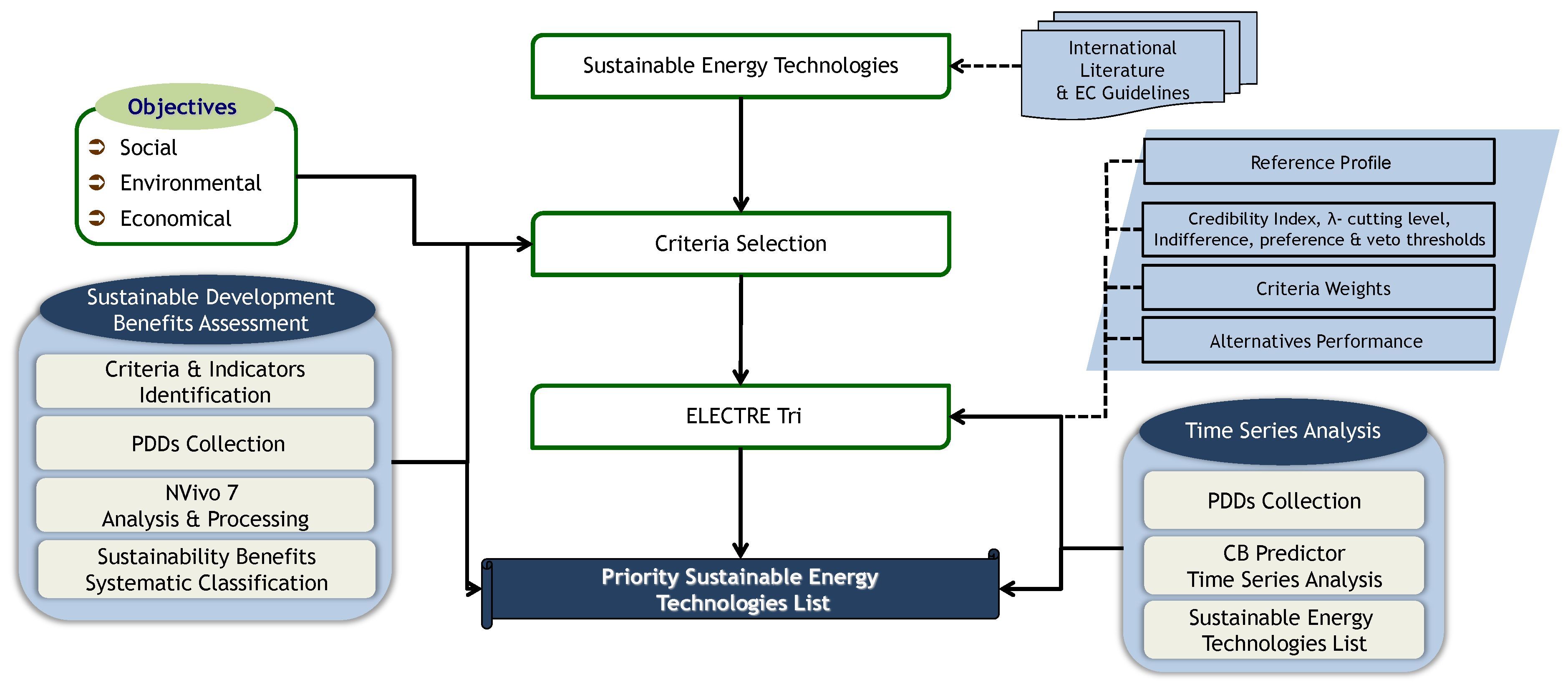
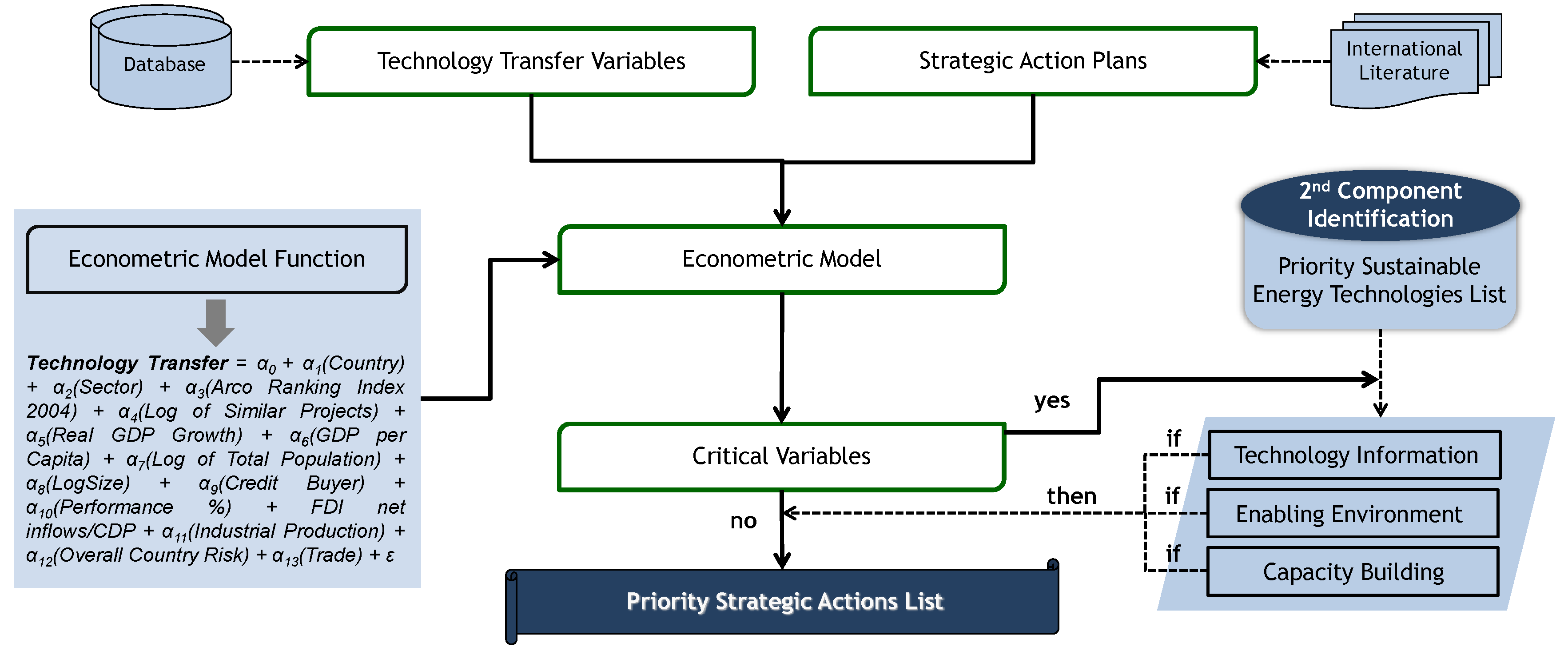
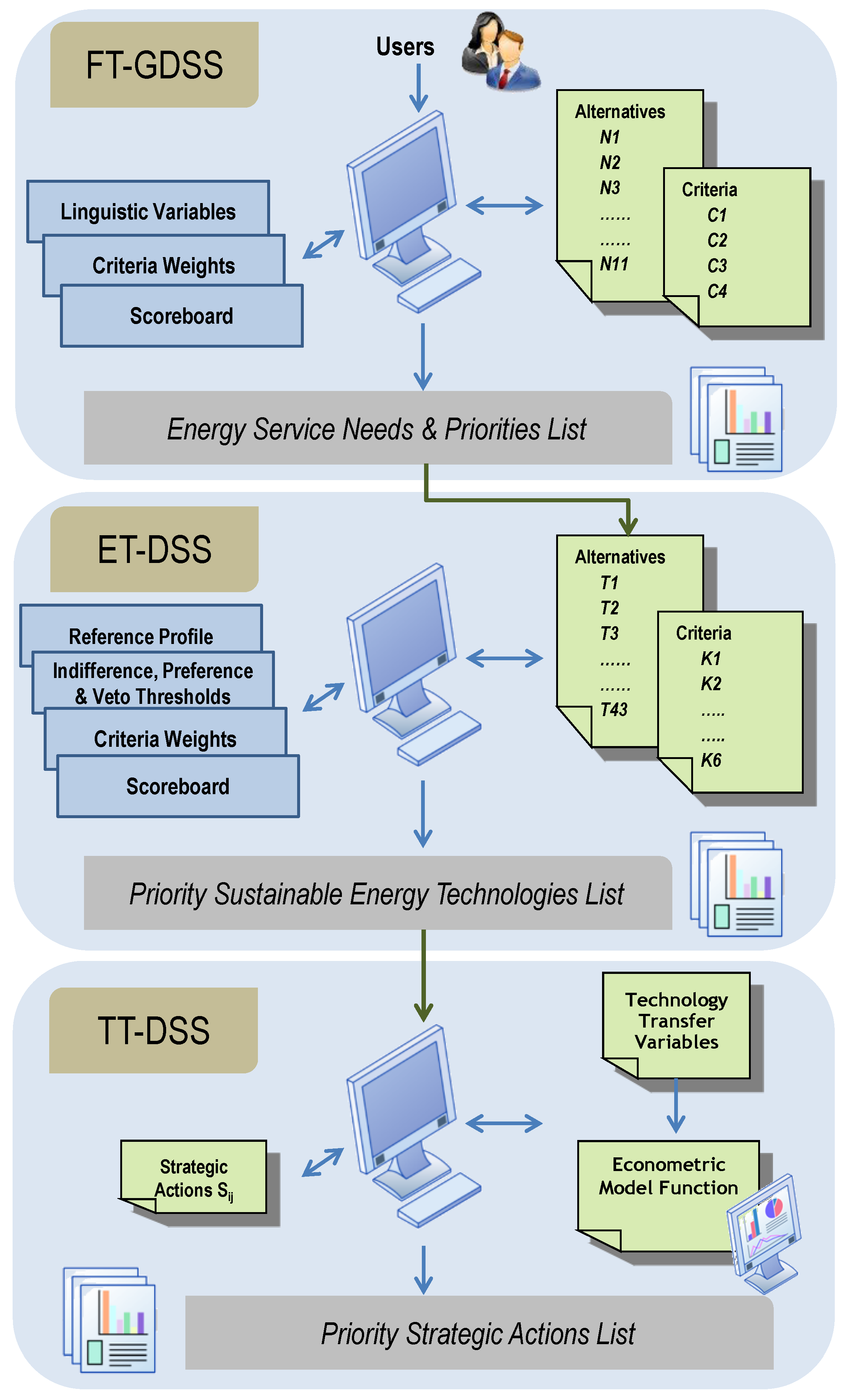
| Energy Needs | Energy services alternatives | Sustainable Energy Technology Alternatives |
|---|---|---|
| Electricity | N1: Electricity for industry; N2: Electricity for agriculture; N3: Electricity for households—rural communities; N4: Electricity for households—urban communities; N5: Electricity for service sectors | T1: Biomass gasification; T2: Steam boiler upgrading; T3: Wind energy; T4: SC PC; power plants; T5: Oil steam improvement; T6: Coal steam improvement; T7: Biogas; T8: Geothermal energy; T9: Solar lanterns; T10: Solar energy (PV); T11: Solar towers; T12: Solar pods; T13: Ocean, wave and tidal energy; T14: Hydro (dams); T15: CMM; T16: Coal-to-gas; T17: Small-scale hydro energy; T18: Small-scale CHP production; T19: Mini/micro hydro (rivers); T20: IGCC power plants; T21: CHP coal/gas-based; T22: CSP; T23: Biomass combustion for electricity and heat; T24: Methane capture at landfills for electricity; T25: Clean coal; T26: Hybrid technology; T27: Hydrogen |
| Heat | N6: Heat for industry; N7: Heat for households; N8: Heat for service sectors | T28: Heat pumps for space heating/cooling and water heating; T29: Solar thermal; T30: Solar pods; T31: Small-scale CHP production; T32: CHP coal/gas-Based; T33: Biomass combustion for electricity and heat |
| Cooling | N9: Energy for Cooling for all Sectors | T34: Heat pumps for space heating/cooling and water heating; T35: Solar cooling and hybrid systems with heating and hot water |
| Energy Efficiency | N10: Energy Efficiency in Industry | T36: Energy efficiency in buildings; T37: Energy efficiency in iron and steel industry; T38: Energy efficiency in the cement industry; T39: Energy efficiency in the agrifood industry; T40: CFL |
| Waste Management | N11: MSW management for energy | T41: Gasification of MSW for large-scale electricity/heat; T42: Landfill gas methane capture (MSW); T43: Combustion of MSW |
| Strategic Actions Categories | Chile | China | Israel | Kenya | Thailand |
|---|---|---|---|---|---|
| Technology Information | Sa1, Sa4 | Sa2, Sa3 | Sa2, Sa3 | Sa1, Sa4, Sa5 | Sa1, Sa2 |
| Enabling Environment | Sb2, Sb3, Sb4 | Sb1, Sb3, Sb4 | Sb2, Sb3, Sb4 | Sb2 | Sb2, Sb3, Sb5 |
| Capacity Building | Sc1, Sc3, Sc4, Sc5 | Sc2 | Sc2, Sc3 | Sc1, Sc2, Sc3, Sc4, Sc5 | Sc1, Sc2, Sc3 |
| Strategic Actions Categories | A/A | Priority Strategic Actions in Chile |
|---|---|---|
| Technology Information | 1 | Sa1: implementation of training programmes and workshops for building capacity in technology information |
| 2 | Sa4: elaboration of reports on the R&D needs | |
| Enabling Environment | 3 | Sb2: strengthening the regulatory frameworks/enhancement of legal systems |
| 4 | Sb3: integration of technology transfer into national policies | |
| 5 | Sb4: bilateral and multilateral cooperation programmes for the promotion of technology transfer | |
| Capacity Building | 6 | Sc1: R&D funding programs |
| 7 | Sc3: activities to increase, enhance or improve awareness and knowledge of sustainable energy technologies and their transfer in a host country | |
| 8 | Sc4: Establishment of national or regional R&D centres | |
| 9 | Sc5: provision or support training activities for the development and transfer of technologies in a host country |
| Strategic Actions Categories | A/A | Priority Strategic Actions in China |
|---|---|---|
| Technology Information | 1 | Sa2: elaboration of national communications with information on technology |
| 2 | Sa3: elaboration of technical studies that explore barriers, good practices and recommendations | |
| Enabling Environment | 3 | Sb1: creation of an environment conducive to investment |
| 4 | Sb3: integration of technology transfer into national policies | |
| 5 | Sb4: bilateral and multilateral cooperation programmes for the promotion of technology transfer | |
| Capacity Building | 6 | Sc2: elaboration of reports on capacity-building needs and experiences of the host country relating to the development, deployment, diffusion and transfer of technologies |
| Strategic Actions Categories | A/A | Priority Strategic Actions in Israel |
|---|---|---|
| Technology Information | 1 | Sa2: elaboration of national communications with information on technology |
| 2 | Sa3: elaboration of technical studies that explore barriers, good practices and recommendations | |
| Enabling Environment | 3 | Sb2: strengthening the regulatory frameworks/enhancement of legal systems |
| 4 | Sb3: integration of technology transfer into national policies | |
| 5 | Sb4: bilateral and multilateral cooperation programmes for the promotion of technology transfer | |
| Capacity Building | 6 | Sc2: elaboration of reports on capacity-building needs and experiences of the host country relating to the development, deployment, diffusion and transfer of technologies |
| 7 | Sc3: Activities to increase, enhance or improve awareness and knowledge of sustainable energy technologies and their transfer in a host country |
| Strategic Actions Categories | A/A | Priority Strategic Actions in Kenya |
|---|---|---|
| Technology Information | 1 | Sa1: implementation of training programmes and workshops for building capacity in technology information |
| 2 | Sa4: elaboration of reports on the R&D needs | |
| 3 | Sa5: establishment of technology information centres and networks | |
| Enabling Environment | 4 | Sb2: strengthening the regulatory frameworks/enhancement of legal systems |
| Capacity Building | 5 | Sc1: R&D funding programs |
| 6 | Sc2: elaboration of reports on capacity-building needs and experiences of the host country relating to the development, deployment, diffusion and transfer of technologies | |
| 7 | Sc3: activities to increase, enhance or improve awareness and knowledge of sustainable energy technologies and their transfer in a host country | |
| 8 | Sc4: establishment of national or regional R&D centres | |
| 9 | Sc5: provision or support training activities for the development and transfer of technologies in a host country |
| Strategic Actions Categories | A/A | Priority Strategic Actions in Thailand |
|---|---|---|
| Technology Information | 1 | Sa1: implementation of training programmes and workshops for building capacity in technology information |
| 2 | Sa2: elaboration of national communications with information on technology | |
| Enabling Environment | 3 | Sb2: strengthening the regulatory frameworks/enhancement of legal systems |
| 4 | Sb3: integration of technology transfer into national policies | |
| 5 | Sb5: policy arrangements for the promotion of international scientific and technological cooperation | |
| Capacity Building | 6 | Sc1: R&D funding programs |
| 7 | Sc2: elaboration of reports on capacity-building needs and experiences of the host country relating to the development, deployment, diffusion and transfer of technologies | |
| 8 | Sc3: activities to increase, enhance or improve awareness and knowledge of sustainable energy technologies and their transfer in a host country |
© 2016 by the author; licensee MDPI, Basel, Switzerland. This article is an open access article distributed under the terms and conditions of the Creative Commons Attribution (CC-BY) license (http://creativecommons.org/licenses/by/4.0/).
Share and Cite
Karakosta, C. A Holistic Approach for Addressing the Issue of Effective Technology Transfer in the Frame of Climate Change. Energies 2016, 9, 503. https://doi.org/10.3390/en9070503
Karakosta C. A Holistic Approach for Addressing the Issue of Effective Technology Transfer in the Frame of Climate Change. Energies. 2016; 9(7):503. https://doi.org/10.3390/en9070503
Chicago/Turabian StyleKarakosta, Charikleia. 2016. "A Holistic Approach for Addressing the Issue of Effective Technology Transfer in the Frame of Climate Change" Energies 9, no. 7: 503. https://doi.org/10.3390/en9070503
APA StyleKarakosta, C. (2016). A Holistic Approach for Addressing the Issue of Effective Technology Transfer in the Frame of Climate Change. Energies, 9(7), 503. https://doi.org/10.3390/en9070503






